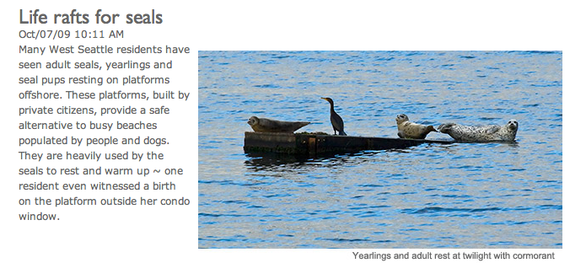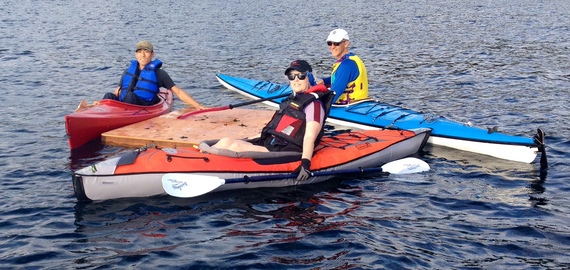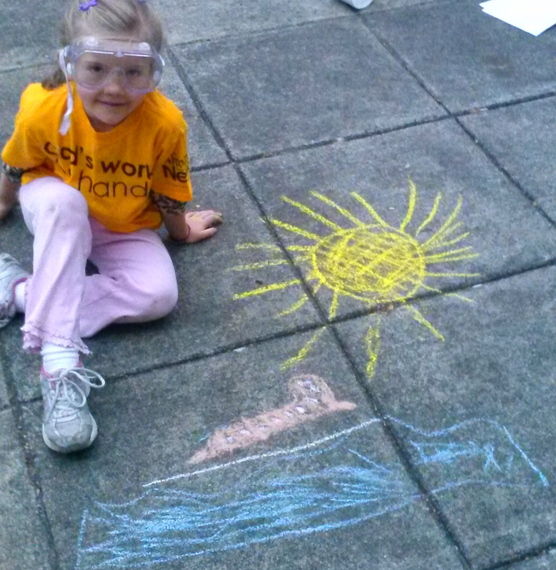An urgent ding of a neighbor's text -- not a disaster, a visitor.
"Large seal on our life raft now!"
Bleary-eyed, I grab my bedside binoculars. Sure enough, a huge and healthy seal is resting on the floating raft we've just anchored in Seattle's Salish Sea. In the marine mists of morning, she arches in the banana pose to regulate her body temperature.
Her pectoral fins stretch out like small wings. Here on this well-crafted raft, she is safe from onshore dangers of a busy beach: off-leash dogs, joggers, curious people with cell phones who stand so close they frighten the seals back into the water -- just when they most need to rest and share our beaches.
"Looks like a healthy adult with good body weight," the texts zing as we alert each other to the welcome presence of our wild neighbors on our life raft.
I also send messages to Seal Sitters, the grassroots conservation group I co-founded in 2007 with photographer, Robin Lindsey. Now part of the Northwest Marine Mammal Stranding Network, Seal Sitters works with NOAA (National Oceanic and Atmospheric Administration) to help train volunteers to help keep our beaches safe for marine life.
Though harbor seals are not an endangered species in Washington State, 50 percent of seal pups do not survive their first year. Pollution, predators -- both human and animal -- marine debris, like plastic balloons or lethal, abandoned fishing lines, kills many marine mammals each year. Seals spend half of their lives on shore -- giving birth, mating, nursing, resting, seeking community. Autumn, when the pups are getting weaned, is a crucial time for seal pups to rest from the exhausting work of fishing for themselves for the first time.
A splash near the life raft. "Whoah!" I text to the Seal Sitting phone tree. "Juvenile pup also hauled out on the life raft. Now two seals!"
"Mom AND Pup pair?" a neighbor shoots back.
It's hard to tell if this is a mother and her pup, even with good binoculars. The larger seal shines a speckled white in the rising sunlight; the smaller pup is darker and nestles very close to the adult.
"Could be mother-pup!" I happily text. "Or yearling and adult."
I marvel at how relaxed the seals seem floating on their little life raft together. No harassment from the busy shore life of humans, no boaters racing by. We're witnessing a serene, still moment with wild animals, right in out own backyards. This time, Seal Sitters do not have to come to the crowded beach with our yellow "Protected Marine Mammal" caution tape to safeguard the seal on shore; we do not have to explain to the many strollers by, "No, the pup is not dead. Please share the shore so the pup can rest."
This life raft to protect marine life is one of several anchored off-shore here in the Salish Sea. The raft was built by Peace Lutheran, a local green church well recognized by Earth Ministry for their conservation work. "God's work, our hands," is their mantra. Caring for both people and the natural world is their mission.
"We can put our hands and bodies to work for the sake of restoring God's good Creation," Pastor Erik Kindem said when we kayaked out in September to set the raft in the Salish Sea.
His building committee, led by Michael Trogue, included women and children, and a fisherman who told me, "I used to hate seals, until I built this raft for them. Then, I realized that we're a lot alike. We both need to rest and to fish."
With the boat and help of Jon Daniels, owner of our local Seattle Fish Company, we hooked the life raft up to his anchor. In our kayaks, we all lay our hands on the life raft as Pastor Erik blessed it with the promise:
We will care for all creatures.We will nurture our planet.We will sustain our endangered kin.
Conservation is the work of our future, if our next generations are to survive and thrive. In Smithsonian magazine, Eminent biologist, E.O. Wilson, in his Half Earth biodiversity vision, asks us to return half of the planet to the wild so that we can feel whole again.
It's time now to heal the broken treaties that many of our religions have created by excluding the earth and other animals from our spiritual practice and care. What happens when churches and our spiritual teachers go green? When we leave our man-made temples or mosques to return to the green world in stewardship and connection? When we stop squabbling and fighting over who's going to heaven; or who the righteous can blissfully leave behind?
When we give up what the Salish Sea's protector, Chief Seattle called our "lonely-hearted living" and adopt other species as our kin in "tenderest affection;" we restore and share habitat we have possessed only for our own uses. We again build an ark to carry other animals with us into the future worlds. Our spiritual lives are part of a greater whole that includes the non-human world. What if heaven is here--right here?
We can tend to this earth and other animals with our body and our souls, as if we still live in a Garden of Eden. Start simple. Start local. Plant trees or a butterfly garden; hang a hummingbird feeder. Gather your neighbors or church to restore native grasses or wetlands for migrating birds. Daylight a stream for salmon, create wildlife corridors for migrating animals, or conserve heirloom seeds.
Begin in your own backyards, like Noah. Call upon your church's building committees, your neighborhood councils, and your schools. Project by project, life-raft-by-life raft, ark-by-ark, build something with your good human hands to welcome our wild neighbors. Build it, and the animals will come back to us. They will help us restore our beautiful and battered world. Now, that's my idea of heaven. Of home.
Listen to an NPR story on Seal Sitting:
Brenda Peterson is a National Geographic author of 18 books, including Leopard and Silkie: One Boy's Quest to Save Seal Pups and the memoir, I Want to Be Left Behind: Finding Rapture Here on Earth. Her writing guide, Your Life is a Book: How to Craft and Publish Your Memoir is just out. For more: www.BrendaPetersonBooks.com





